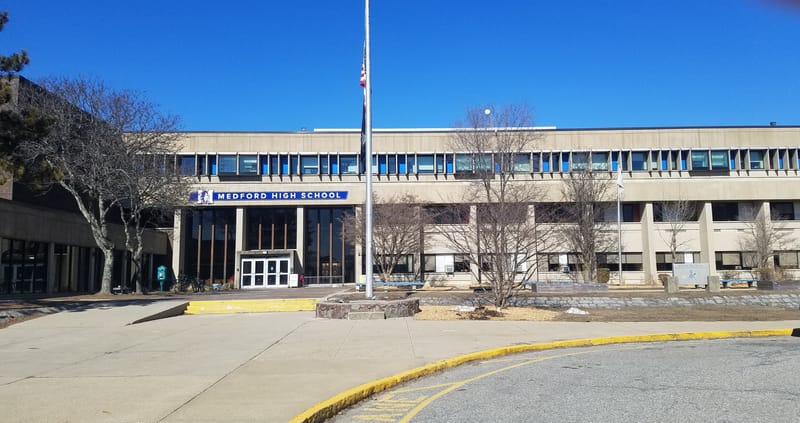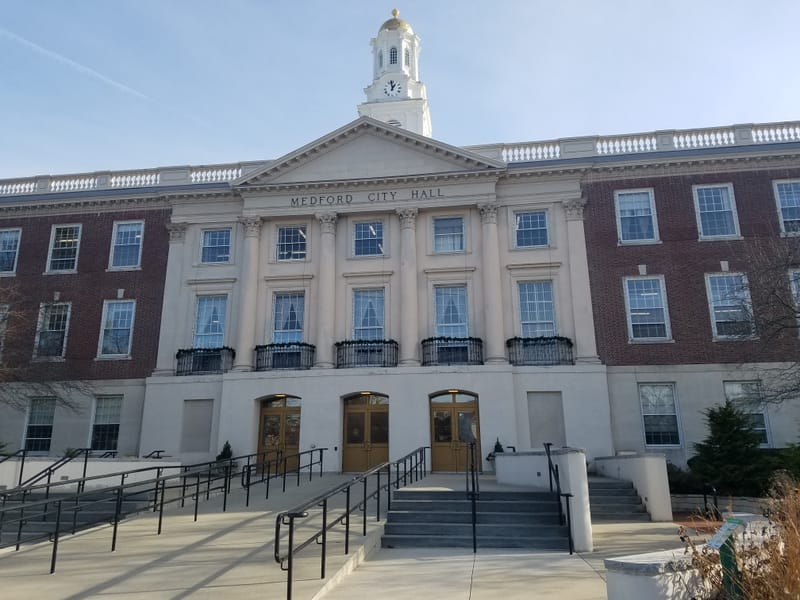Medford City Council president asks for zoning process extension, more funding for communication
Medford City Council President Isaac “Zac” Bears has asked for an extension and more funding for the city’s zoning overhaul, which he called a “shared path forward.”
By Neil Zolot, Correspondent
Medford City Council President Isaac “Zac” Bears has asked for an extension and more funding for the city’s zoning overhaul, which he called a “shared path forward.”
Bears made his plea during a meeting of the Council Planning and Permitting Subcommittee on July 16.
“I call on my fellow councilors, Community Development Board (CBD) and our planning team to prioritize completing the proposed commercial framework and focus our work on the remaining proposed districts for Medford Square, West Medford Square, the ‘Other Corridors’ and Tufts Institutional Zoning this year,” he began. “Second, I call on my fellow councilors, the Community Development Board and the planning team to extend the process for reviewing the proposed residential districts, accessory dwelling units (ADUs) and updates to the off-street parking requirements through spring 2026.
“I ask the CDB to continue to deliberate on a new set of recommendations regarding the residential districts in August and hold public hearings on their updated recommendations, as well as any off-street parking proposals, in September, October and November before sending any final recommendations to the council,” he continued. “In advance of the council’s receipt of the CDB’s recommendations, I propose the council adopt a schedule for additional public hearings in January and February before scheduling any final votes no earlier than March 2026, and allow for additional time through May 2026 if it is requested by the CDB.
“Third, and most importantly, I call on the mayor to allocate the necessary resources from our city’s reserve funds to provide the council, CDB, planning team and city staff with the support needed to conduct even more robust public outreach over the next year,” Bears added. “Specifically, I call on the mayor to place an appropriation paper before the council by September that provides at least $150,000 in total funds (including any funds currently appropriated in the fiscal year 2026 budget) to extend our contract with Innes Associates through December 2026, and provide an additional $50,000 to pay for communications to residents that are reviewed and approved by the consensus of all of the branches of the city leading the project (Mayor’s Office, City Council, and Planning Department) that help inform residents about the proposals and what opportunities they will have to make their voices heard and share their comments with the CDB and the City Council.”
Bears went on to say, “It was a mistake that I did not speak up earlier and more loudly to get the mayor to commit more funding and resources to this project. I should not have accepted that an 18-month contract was the best we could get nor that we should try to keep our promises to the voters and accomplish this project in that timeframe.
“I regret I did not share more publicly the efforts we have implemented to extend this process to hear from more residents. I wish I had lifted up the work of my colleagues who have done so much to try to improve the communications effort for this project with the limited resources available by asking for more time, more resources and more funding sooner,” he continued. “That’s why tonight, I am outlining this shared path forward so we can accomplish what we set out to do more than five years ago and adopt a zoning ordinance we believe will build the future of our city we want the residents to celebrate.”
There was no reaction to Bears’ speech from members of the subcommittee or audience members. The meeting then continued on to the only item on the agenda: Tufts University.
The meeting
Consultants Emily Innes and Grant Perry, of Innes Associates, were on hand to discuss updates on zoning revisions involving Tufts. No definite decisions were made, with Innes and Grant using the evening to identify and publicize issues that will affect future zoning in the area.
The subject for the evening was a discussion of a Tufts University Institutional Zoning Framework.
No decisions were made, with Innes and Grant using the meeting to identify and publicize issues that will affect future zoning in the area.
“This is about what we need to think about,” Innes said.
Considerations fall into a number of frameworks for use, dimensional considerations, procedural considerations and miscellaneous items.
Use Considerations are about what non-educational uses should be allowed in the district by-right and if there are some non-educational uses that should be allowed by special permit.
“I don’t think it should be by-right,” Innes said. “There should be some site plan review process.”
The definition of a non-educational use is vague. A campus store would probably fit into that category, but other non-classroom space might not. Perry said educationally significant space, like dormitories and recreational facilities that contribute to campus life, could be considered “educational.”
Dimensional Considerations include the dimensional limits applied to all buildings, but also involve how and what standards would be applied to all or some abutting residential districts and if there should be a density gradient along abutting residential properties with less densely populated or tall buildings closer to residential areas and more density and height in the center of the campus.
Procedural Considerations involve how the city can be involved in the planning process in terms of project reviews and site plan reviews.
Foremost among miscellaneous considerations is parking.
A huge factor that has to be taken into consideration by the city is the Dover Amendment (Massachusetts General Law, Chapter 40A Section 3) which reads, “No zoning ordinance or by-law shall regulate or restrict the interior area of a single family residential building nor shall any such ordinance or by-law prohibit, regulate or restrict the use of land or structures for religious purposes or for educational purposes on land owned or leased by the commonwealth or any of its agencies, subdivisions or bodies politic or by a religious sect or denomination, or by a nonprofit educational corporation; provided, however, that such land or structures may be subject to reasonable regulations concerning the bulk and height of structures and determining yard sizes, lot area, or reasonable regulations concerning the bulk and height of structures and determining yard sizes, lot area, setbacks, open space, parking and building coverage requirements.”
What does that mean?
“The Dover Amendment, as it presently stands, seeks to strike a balance between preventing local discrimination against an educational use, and honoring legitimate municipal concerns that typically find expression in local zoning laws,” Innes explained, adding the amendment was already used during a legal action between Tufts and the city in 1999. “Nothing in the Dover Amendment mandates the adoption of local zoning laws which are tailored specifically to educational uses. However, the court observes that ideally regulations should be specifically adapted to educational uses.”
“The Dover Amendment limits how the city can affect the university,” Medford Planner Danielle Evans added.
Other information provided by Innes outlined myriad arguments and procedures for determining what is reasonable and unreasonable in terms of educational and non-educational uses and zoning regulations related to those uses.
Innes also provided information on how communities hosting colleges and universities have handled zoning related to those institutions, including Amherst, Boston, Dartmouth, Fitchburg, Salem, Waltham, Wellesley and Worcester.
A possible alternative
An alternative to the zoning issues revolving around Tufts could be an Institutional Master Plan (IMP).
According to the City of Boston’s Planning Department, which uses such a tool when dealing with hospitals and educational institutions, “a comprehensive development plan that describes an institution’s existing facilities, long-range planning goals, and proposed projects. IMPs also identify potential impacts on surrounding communities and outline proposed community benefits. The process of creating IMPs ensures that campus evolution occurs in a thoughtful and transparent manner.”
The city of Salem, which is similar in size to Medford, has an IMP in place because of Salem State University. But each IMP is unique.
“We’d like one,” Bears said. “It’s an important tool for us to advocate for, but Tufts is against it.”
Councilor Kit Collins, who chairs the subcommittee, agreed.
“It’s important to make sure new zoning holds Tufts to account,” she said. “Hopefully, the winds will change and we can get an IMP.”
But there is a hurdle in doing that.
“We can’t force them to do it without a home rule petition,” Evans said.
Any formation of an IMP could and should involve the city.
“Ideally, it would be cooperative with synergy to find mutual goals,” Evans added.
In the meantime, Tufts can do pretty much what it wants.
“They share what they want to share,” Evans said.
One recent development is building new dormitories to house upperclassmen, which could keep more students living on campus and not in the neighborhoods.
“It’s important to allow Tufts to center housing on its campus to avoid driving student into houses off campus that would be occupied by residents,” Collins said.
Her sentiments were echoed by a number of residents in comments from the public.





